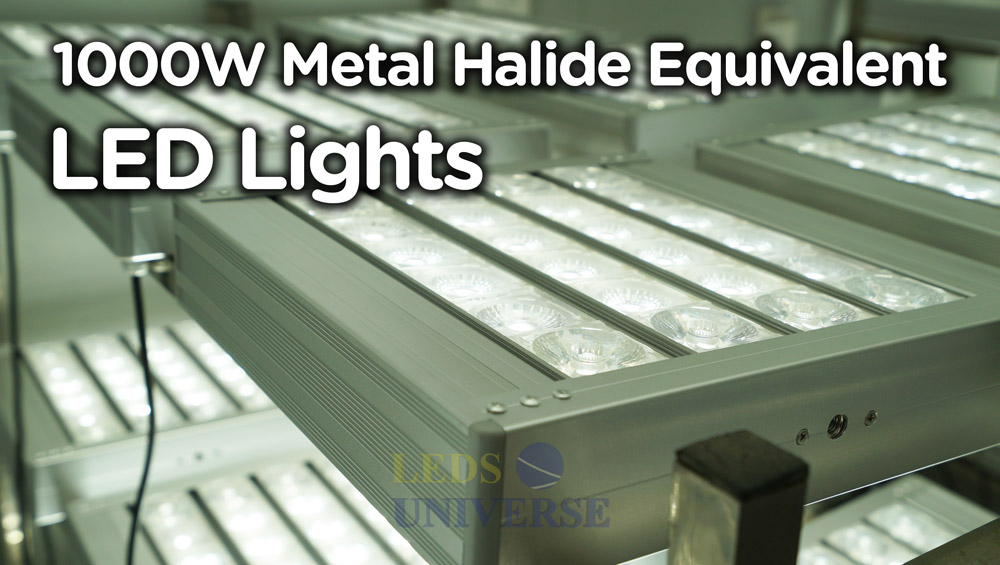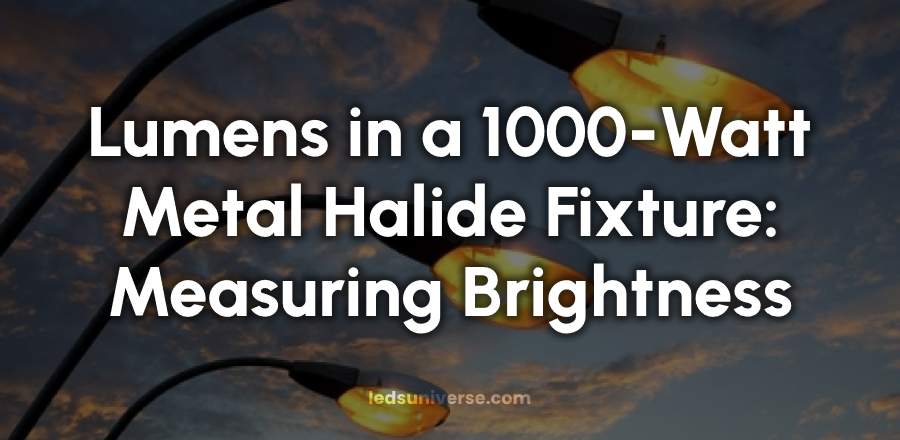In the world of lighting, understanding the differences in lumen output between various types of bulbs is crucial for making informed choices. Metal halide lamps, particularly those of 1000 watts and 400 watts, are prevalent in various applications. However, with the increasing popularity of LED technology, questions arise about how these two lighting options compare in terms of brightness. The comparison often focuses on the question: how many lumens does a 1000-watt metal halide lamp produce compared to LED lights?

Table of Contents
ToggleLumen Output of Metal Halide Lamps
Metal halide lamps have been a staple in the lighting industry for decades, known for their bright, white light. A 1000-watt metal halide lamp can produce between 50,000 to 100,000 lumens, depending on the specific type and brand. This substantial lumen output makes them a popular choice for applications requiring high-intensity lighting, such as stadiums, warehouses, and parking lots.
Conversely, a 400-watt metal halide bulb typically emits around 24,000 to 44,000 lumens. Understanding the lumen output is crucial when considering a replacement for these fixtures, especially with the rise of LED technology.
What is Lumen Output?
Lumen is a unit of measurement that quantifies the amount of light emitted by a fixture. When considering a replacement for existing fixtures, knowing the lumen output is vital. For example, if a metal halide fixture produces 100,000 lumens at 1000 watts, one would not need to replace it with another 1000-watt LED. Instead, an LED capable of producing an equivalent lumen output would suffice.
When replacing a metal halide bulb with an LED, focusing on lumen output rather than wattage is advisable. LEDs are generally more efficient and can produce the same amount of light while consuming less power.
Comparing Lumens: LED vs. Metal Halide
| Type of Light | Wattage | Lumen Efficiency (Lumens per Watt) | Total Lumen Output (Lumens) |
|---|---|---|---|
| Metal Halide | 1000 watts | 60 to 110 | 50,000 to 100,000 |
| LED | Varies | Approximately 140 | Higher efficiency, varies by wattage |
Understanding the Efficiency Difference
The disparity in lumen output can be attributed to the way each type of lighting system operates. The ballast used in metal halide lamps transfers energy with an efficiency of only 60% to 80%. Consequently, a portion of the energy consumed is wasted within the ballast itself. Initially, the ballast may consume up to 15% more energy than what is ultimately converted to light.
To generate the same lumen output as a 1000-watt metal halide bulb, a power input of approximately 1200 to 1400 watts may be required. This scenario results in a decreased light efficiency, ranging from 36 to 88 lumens per watt.
The Advantage of LED Technology
High-power LED systems typically have a shorter development time, lasting around 10 years. A 1000-watt LED can yield between 130 to 200 lumens per watt. Moreover, the LED power supply driver has a high conversion rate, achieving around 95% efficiency. The average lumen output for LEDs ranges from 95 to 190 lumens per watt, making them significantly more efficient than metal halide lamps.
Applications of Metal Halide Lamps
Metal halide lamps emerged in the 1960s and have since been recognized as one of the earliest high-intensity lighting sources. They are particularly suitable for illuminating large areas, such as airports, warehouses, parking lots, stadiums, and sports fields. These lamps are also commonly used in street lighting and construction sites, depending on the illumination requirements.
Versatility in Use
The unique characteristics of metal halide lamps make them ideal for environments where high illumination is needed. Their ability to produce a bright, white light allows for excellent visibility, which is crucial in applications like sports events and large public gatherings. However, the advent of LED technology has prompted many to reconsider their lighting options, given the numerous benefits that LEDs offer.

Benefits of Replacing Metal Halide with LED
The advantages of switching from metal halide bulbs to LED technology are numerous. One significant difference is the longevity of the two options. Metal halide bulbs tend to lose a considerable amount of their lumen output within the first six months of operation, while LEDs maintain their brightness over a much longer period.
Longevity and Performance
Although metal halide bulbs have an operational life of approximately 15,000 to 20,000 hours, they lose a significant portion of their lumen output early in their lifespan. In contrast, LEDs are known for their superior energy efficiency, which can lead to substantial cost savings over time. This longevity results in less frequent replacements and lower maintenance costs.
When considering a switch from metal halide to LED lighting, focusing on lumen output rather than wattage is vital. This approach ensures that the new LED fixture meets or exceeds the lumen requirements of the existing metal halide fixture, resulting in optimal lighting performance.
Additional Cost Savings
LEDs also offer financial advantages. While the initial investment for LED fixtures may be higher than that of metal halide bulbs, the long-term savings on energy bills can offset this initial cost. With the energy efficiency of LEDs, users can expect to see a significant reduction in electricity consumption, which translates to lower utility bills.
Transitioning to LED: What to Consider
When transitioning from metal halide to LED lighting, several factors should be taken into account. First and foremost, one must assess the lumen output required for the specific application. Ensuring that the new LED fixture can provide the necessary brightness is paramount.
Evaluating Color Temperature
Additionally, considering the color temperature of the new lighting is important. LEDs are available in a range of color temperatures, allowing for customization based on the needs of the space being illuminated. A cooler color temperature may be more appropriate for certain settings, while warmer tones may be preferable in others.
Dimming Capabilities
Another factor to consider is the dimming capabilities of the new LED fixtures. Many modern LED systems offer the ability to adjust brightness levels, providing flexibility in lighting design. This feature can be particularly beneficial in settings where lighting needs may change throughout the day or in response to specific activities.
The comparison between metal halide and LED lighting reveals significant differences in lumen output, efficiency, and longevity. By understanding these distinctions, one can make informed decisions when selecting lighting solutions for various applications. Embracing LED technology not only leads to brighter and more efficient lighting but also contributes to a more sustainable future.
Conclusion
Metal halide lamps, particularly those rated at 1000 watts and 400 watts, have long been used in diverse applications, thanks to their capacity to deliver substantial brightness. However, the rise of LED technology presents a compelling alternative that warrants consideration.
The comparison often revolves around how many lumens a 1000-watt metal halide lamp produces in contrast to LED lights. As illustrated, metal halide lamps can emit between 50,000 and 100,000 lumens, while LEDs can achieve lumen outputs of 130 to 200 lumens per watt, emphasizing their superior efficiency. This efficiency translates not only into energy savings but also into reduced environmental impact, making LEDs a more sustainable choice for the future.
